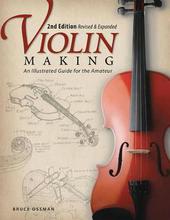
|
Violin Making, Second Edition Revised and Expanded: An Illustrated Guide for the Amateur
Paperback / softback
Main Details
| Title |
Violin Making, Second Edition Revised and Expanded: An Illustrated Guide for the Amateur
|
| Authors and Contributors |
By (author) Bruce Ossman
|
| Physical Properties |
| Format:Paperback / softback | | Pages:104 | | Dimensions(mm): Height 279,Width 216 |
|
| Category/Genre | String instruments
Decorative wood and metalwork |
|---|
| ISBN/Barcode |
9781565234352
|
| Classifications | Dewey:787.21923 |
|---|
| Audience | |
|---|
| Edition |
Expanded
|
| Illustrations |
170 Line drawings, unspecified; 4c
|
|
Publishing Details |
| Publisher |
Fox Chapel Publishing
|
| Imprint |
Fox Chapel Publishing
|
| Publication Date |
1 September 2009 |
| Publication Country |
United States
|
Description
Author and lifelong teacher Bruce Ossman uses his simple techniques and clear instruction to guide you through every single step of making a violin. With a complete list of tools, full-size patterns, detailed illustrations, and templates for every piece all included, you'll craft an instrument fit for an orchestra.
Author Biography
Bruce Ossman is a retired teacher. His love of classical music (especially that of the baroque era) and his interest in simplifying the overwhelming art of violin making inspired him to publish this book.
ReviewsPacked with full-size patterns, step-by-step instructions - a nice departure from the usual use of photographs - you too can craft a wonderful instrument. I suspect that the book that Bruce Ossman has written, is the book he wishes he had available to him when he first fell in love with the violin while a student at Penn State University in the 1950s. It wasn't long before he self-taught himself to make his first instrument. As the sub-title of the book indicates, this book is not intended for the serious luthier making concert level instruments. Ossman's book is aimed at the average woodworker or motivated musician wishing to build a decent sounding, playable violin on his or her first attempt. The book begins with an overview of the entire 30-step building process utilizing many line drawings and sparse text. It's an excellent way to convey, to the novice builder, the violin in its deconstructed state and the logical sequence of steps necessary to pull it all together. This is followed by a gallery of color photos of the work of five makers, some amateurs and some professional. If one needs some inspiration before beginning a project, this section will provide it. The first chapter is devoted to the violin's anatomy and acoustics. Although there is enough literature on these topics alone to float a battleship, Ossman manages to cover the absolute bare-bone basics in just a few pages. The second chapter covers the materials which go into a violin as well as some of the preparatory steps necessary to build an instrument, including the fashioning of some simple tools like spool clamps, the body form and carving table. However, the discussion of tone woods, which one would expect in almost any other book on violin making, is almost non-existent here. The author's focus is definitely on construction. The heart of the book is chapter three, where Ossman takes the builder through the nuts and bolts of building a violin. He relies on a great many line drawings and straightforward text. Being so brief, there is no room for an in-depth discussions of why he opted for one method, approach, or material over any number of other options available to him. For example, the matter of finish is a topic about which countless books, articles, and scientific papers have been written, but Ossman simply instructs the builder to apply several coats of varnish with a sanding between coats. That's it. Still, he knows that if the reader follows his instructions, the end result will be a decent instrument, first time out. The appendix includes templates and full-sized plans, some of which are printed over two facing pages with the binding down the middle, but with registration marks so that when photocopied at full-size, they can be taped together. There is no instrument which is more steeped in mythology and lore than the violin, where grown men and women swear that the best instruments are made by the light of the August Moon, using 100 year old German spruce, harvested from the leeward sides of mountains and finished with shellac using some approximation of Stradivarius's mysterious recipe. Serious luthiers like these can discuss ad nauseum the merits of absolutely any aspect of the violin from the shape of the f-holes, to the types of strings used, to the glues employed, to the placement of the sound-post, and more. This is a different kind of book. For the first time builder, there is much to be said for Ossman's straightforward approach, where he has avoided many of the kinds of issues that more experienced builders delight in debating, but which might distract the novice from simply getting on with it.
|